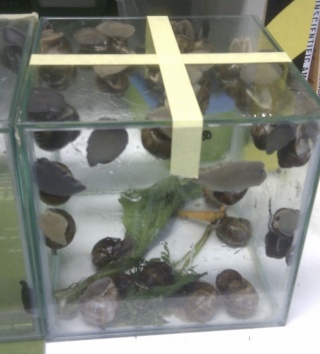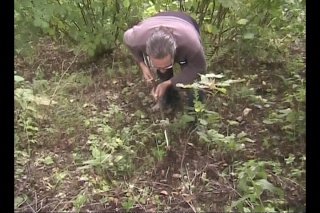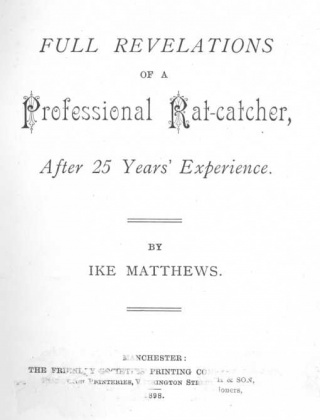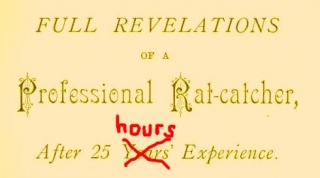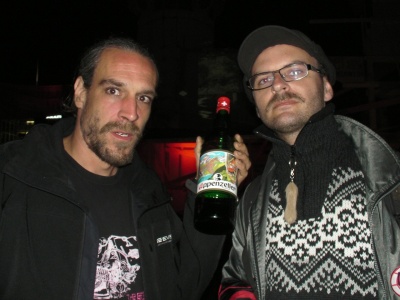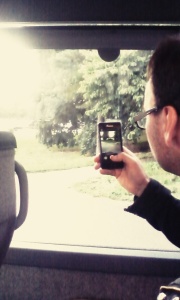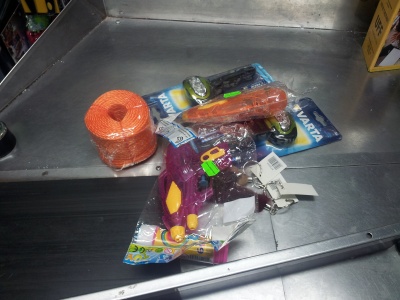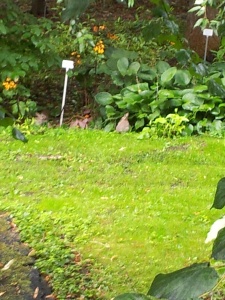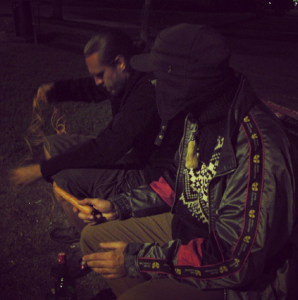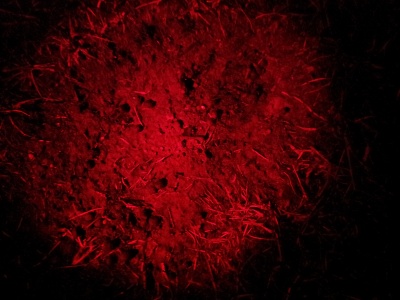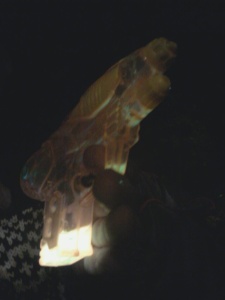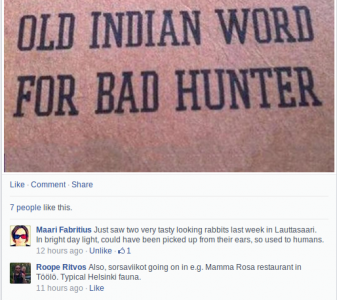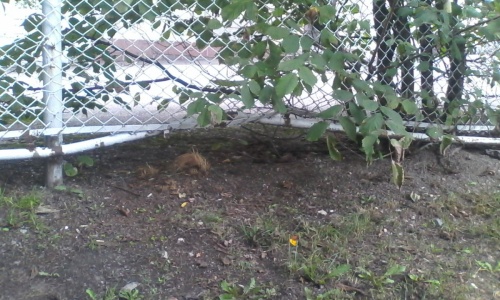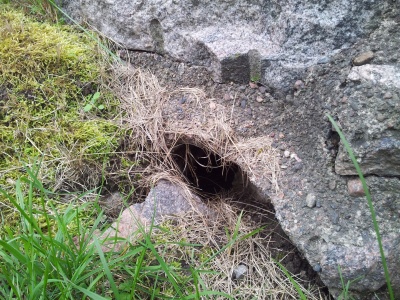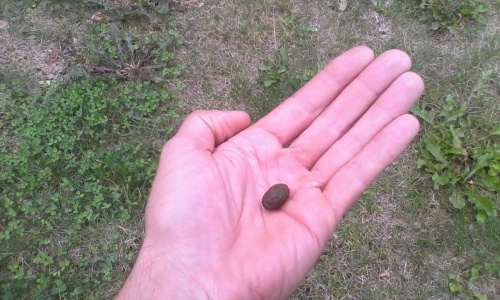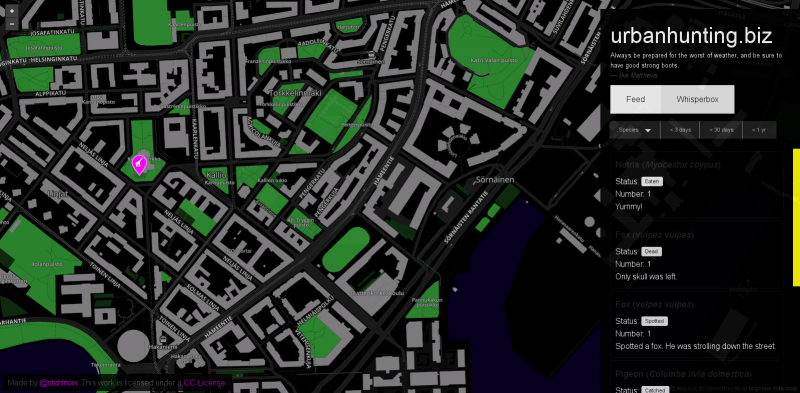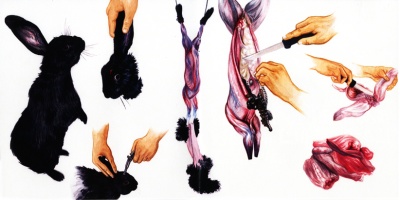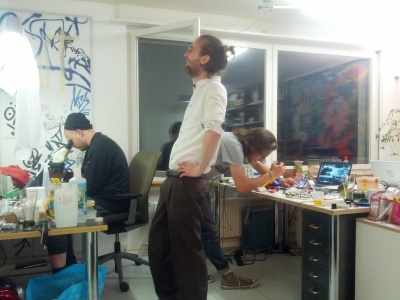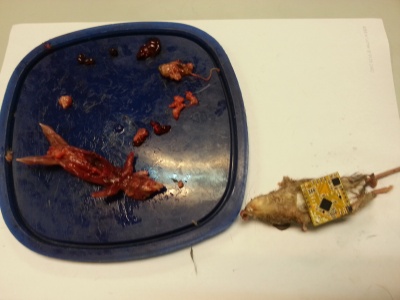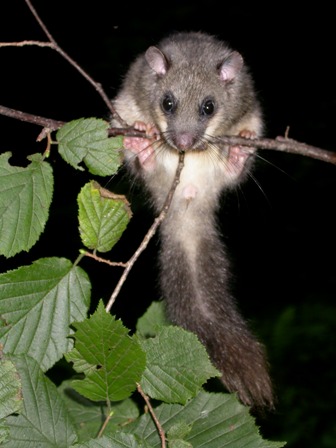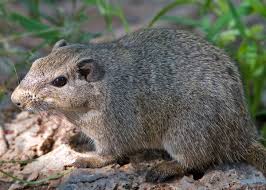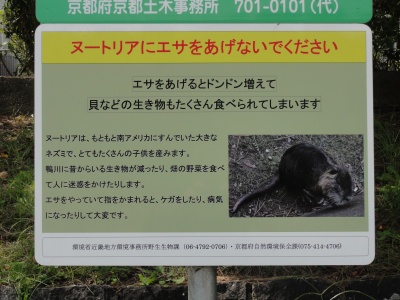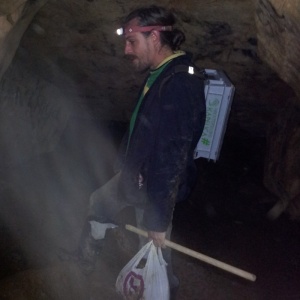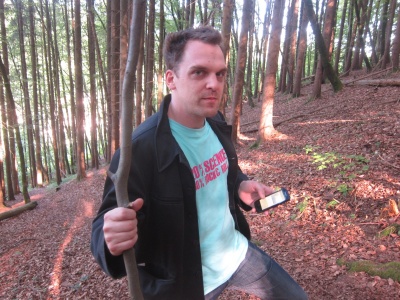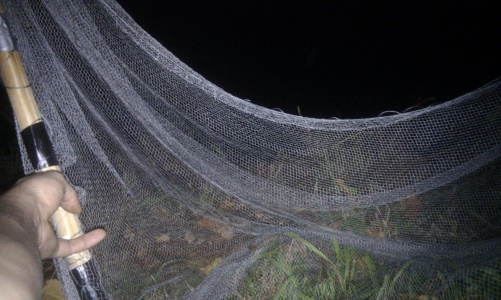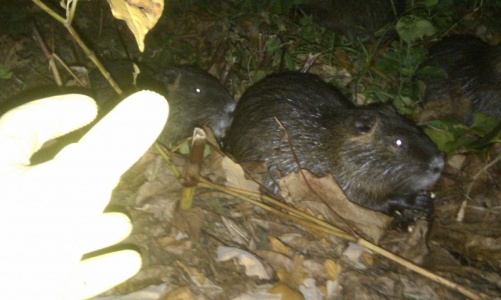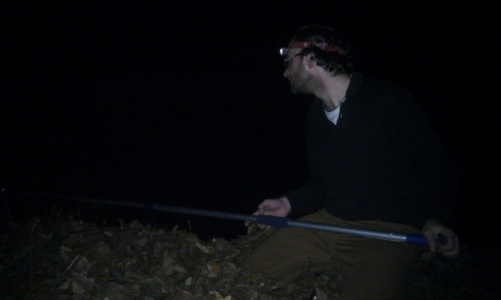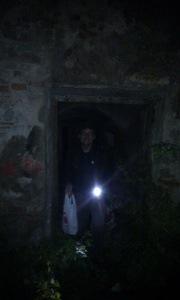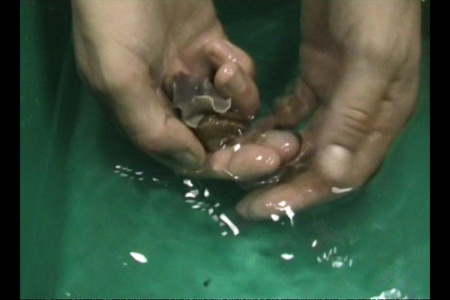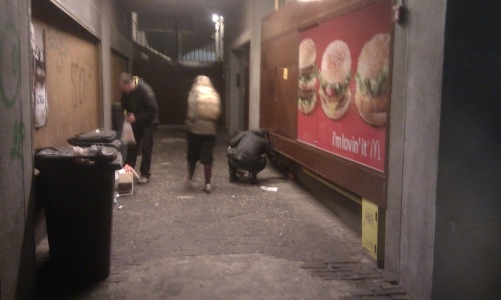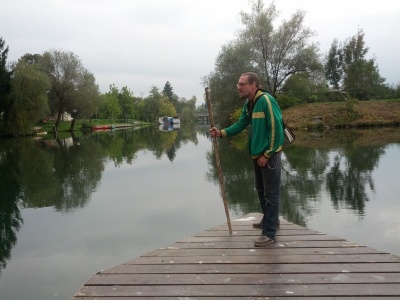Urban Cuisine
Contents
- 1 Session 1 - Snails of Ljubljana, September 2013
- 2 Session 2: Nutria
- 3 Session 3: Rats - Maribor needs us...
- 4 Session 4: Downtown pigeon - Ljubljana
- 5 Session 5: Rabbits - Helsinki
- 5.1 Documentation
- 5.2 Foodycle
- 5.3 Getting started in the Field - Helsinki
- 5.4 More about Rabbits
- 5.5 Rabbit sounds
- 5.6 Rabbits in Helsinki
- 5.7 other related resources
- 5.8 Snaring
- 5.9 Long Netting
- 5.10 Killing Rabbits
- 5.11 On De-domestication and feralization
- 5.12 What is "Villiintyminen"
- 5.13 Urban Hunting App
- 5.14 How to Skin a Rabbit
- 6 Session xx Tikus Celurut - Rumah Lifepatch, Yogyakarta 2014
- 7 Session xx Mouse Hacking @ hackerspace.sg
- 8 Session xx? Foxes - Zürich 2014
- 9 Session xx? Polh-Glis glis - Ljubljana, Slovenija
- 10 Session xx? Dassie Rats - Durban, South Africa
- 11 Session xx? Nutria - Kyoto
- 12 Photo Impressions
- 13 General Links and Ideas about urban hunting
- 14 Theory
Session 1 - Snails of Ljubljana, September 2013
Tools needed
- plastic bag
- (optional: a wooden stick)
Links on heliciculture
The French must know... http://www.gireaud.net/us/heliciculture_us.htm
Nutrional value of snail.....http://www.dietaryfiberfood.com/protein/snail-escargot.php
Snail pie is much more nutritious than a beef pie... http://www.sciencedaily.com/releases/2009/11/091119101207.html
informative video about snails picking, preparation and cooking. For now only in slovenian language; http://www.youtube.com/watch?v=YPkDli0Q75c&feature=c4-overview&list=UU6yDRhma1AY_1YM4Z1rVhcA.
Session 2: Nutria
see some first expeditions on hackteria website
Experiences
Nutria is active at late afternoon. This is time when they get out of there holes at river dock. They love apples. Be patient they will come. Nutria is not disturbed by sound or light not even present of hunter but rapid gesture will make her go in to water. Boat is probably very efficient way to hunt nutria if you don't have gun. Since they usually swim to other side of the river is good practice to position two hunters on both sides of canal. Don't forget cigarettes and beer when going on other side of the river.
Trapping
http://www.youtube.com/watch?v=b-3Wp9F3mP4
http://kieferle.com/jagdbedarf/totschlagfallen/mittlere-tiere/00023.php
hunting and eating
https://www.youtube.com/watch?v=Q0Sn8sA8Bkc
http://www.wwltv.com/news/Golden-Meadow-to-hold-nutria-hunting-rodeo-134394308.html
General Biology, Reproduction, and Behavior
more info about Nutria from http://icwdm.org/handbook/rodents/nutria.asp
Habitat
Nutria adapt to a wide variety of environmental conditions and persist in areas previously claimed to be unsuitable. In the United States, farm ponds and other freshwater impoundments, drainage canals with spoil banks, rivers and bayous, freshwater and brackish marshes, swamps, and combinations of various wetland types can provide a home to nutria. Nutria habitat, in general, is the semiaquatic environment that occurs at the boundary between land and permanent water. This zone usually has an abundance of emergent aquatic vegetation, small trees, and/or shrubs and may be interspersed with small clumps and hillocks of high ground. In the United States, all significant nutria populations are in coastal areas, and freshwater marshes are the preferred habitat.
Food Habits
Nutria are almost entirely herbivorous and eat animal material (mostly insects) incidentally, when they feed on plants. Freshwater mussels and crustaceans are occasionally eaten in some parts of their range. Nutria are opportunistic feeders and eat approximately 25% of their body weight daily. They prefer several small meals to one large meal.
The succulent, basal portions of plants are preferred as food, but nutria also eat entire plants or several different parts of a plant. Roots, rhizomes, and tubers are especially important during winter. Important food plants in the United States include cordgrasses (Spartina spp.), bulrushes (Scirpus spp.), spikerushes (Eleocharis spp.), chafflower (Alternanthera spp.), pickerelweeds (Pontederia spp.), cattails (Typha spp.), arrowheads (Sagittaria spp.), and flatsedges (Cyperus spp.). During winter, the bark of trees such as black willow (Salix nigra) and bald-cypress (Taxodium distichum) may be eaten. Nutria also eat crops and lawn grasses found adjacent to aquatic habitat.
Because of their dexterous forepaws, nutria can excavate soil and handle very small food items. Food is eaten in the water; on feeding platforms constructed from cut vegetation; at floating stations supported by logs, decaying mats of vegetation, or other debris; in shallow water; or on land. In some areas, the tops of muskrat houses and beaver lodges may also be used as feeding platforms.
General Biology
In the wild, most nutria probably live less than 3 years; captive animals, however, may live 15 to 20 years. Predation, disease and parasitism, water level fluctuations, habitat quality, highway traffic, and weather extremes affect mortality. Annual mortality of nutria is between 60% and 80%.
Predators of nutria include humans (through regulated harvest), alligators (Alligator mississippiensis), garfish (Lepisosteus spp.), bald eagles (Haliaeetus leucocephalus), and other birds of prey, turtles, snakes such as the cottonmouth (Agkistrodon piscivorus), and several carnivorous mammals.
Nutria densities vary greatly. In Louisiana, autumn densities of about 18 animals per acre (44/ha) have been found in floating freshwater marshes. In Oregon, summer densities in freshwater marshes may be 56 animals per acre (138/ha). Sex ratios range from 0.6 to 1.6 males per female.
In summer, nutria live on the ground in dense vegetation, but at other times of the year they use burrows. Burrows may be those abandoned by other animals such as armadillos (Dasypus novemcinctus), beavers, and muskrats, or they may be dug by nutria. Underground burrows are used by individuals or multigenerational family groups.
Burrow entrances are usually located in the vegetated banks of natural and human-made waterways, especially those having a slope greater than 45o. Burrows range from a simple, short tunnel with one entrance to complex systems with several tunnels and entrances at different levels. Tunnels are usually 4 to 6 feet (1.2 to 1.8 m) long; however, lengths of up to 150 feet (46 m) have been recorded. Compartments within the tunnel system are used for resting, feeding, escape from predators and the weather, and other activities. These vary in size, from small ledges that are only 1 foot (0.3 m) across to large family chambers that measure 3 feet (0.9 m) across. The floors of these chambers are above the water line and may be covered with plant debris discarded during feeding and shaped into crude nests.
In addition to using land nests and burrows, nutria often build flattened circular platforms of vegetation in shallow water. Constructed of coarse emergent vegetation, these platforms are used for feeding, loafing, grooming, birthing, and escape, and are often misidentified as muskrat houses. Initially, platforms may be relatively low and inconspicuous; however, as vegetation accumulates, some may attain a height of 3 feet (0.9 m).
Reproduction
Nutria breed in all seasons throughout most of their range, and sexually active individuals are present every month of the year. Reproductive peaks occur in late winter, early summer, and mid-autumn, and may be regulated by prevailing weather conditions.
Under optimal conditions, nutria reach sexual maturity at 4 months of age. Female nutria are polyestrous, and nonpregnant females cycle into estrus (“heatâ€) every 2 to 4 weeks. Estrous is maintained for 1 to 4 days in most females. Sexually mature males can breed at any time because sperm is produced throughout the year.
The gestation period for nutria ranges from 130 to 132 days. A postpartum estrus occurs within 48 hours after birth and most females probably breed again during that time.
Litters average 4 to 5 young, with a range of 1 to 13. Litter sizes are generally smaller during winter, in suboptimal habitats, and for young females. Females often abort or assimilate embryos in response to adverse environmental conditions.
Young are precocial and are born fully furred and active. They weigh approximately 8 ounces (227 g) at birth and can swim and eat vegetation shortly thereafter. Young normally suckle for 7 to 8 weeks until they are weaned.
Behavior
Nutria tend to be crepuscular and nocturnal, with the start and end of activity periods coinciding with sunset and sunrise, respectively. Peak activity occurs near midnight. When food is abundant, nutria rest and groom during the day and feed at night. When food is limited, daytime feeding increases, especially in wetlands free from frequent disturbance.
Nutria generally occupy a small area throughout their lives. In Louisiana, the home range of nutria is about 32 acres (13 ha). Daily cruising distances for most nutria are less than 600 feet (183 m), although some individuals may travel much farther. Nutria move most in winter, due to an increased demand for food. Adults usually move farther than young. Seasonal migrations of nutria may also occur. Nutria living in some agricultural areas move in from marshes and swamps when crops are planted and leave after the crops are harvested.
Nutria have relatively poor eyesight and sense danger primarily by hearing. They occasionally test the air for scent. Although they appear to be clumsy on land, they can move with surprising speed when disturbed. When frightened, nutria head for the nearest water, dive in with a splash, and either swim underwater to protective cover or stay submerged near the bottom for several minutes. When cornered or captured, nutria are aggressive and can inflict serious injury to pets and humans by biting and scratching.
Session 3: Rats - Maribor needs us...
http://www.zurnal24.si/podgane-v-srediscu-mesta-clanek-207857
inspirin reads
Full Revelations of a Professional Rat-Catcher, after 25 Years’ Experience
- by Ike Matthews.
http://www.gutenberg.org/files/17243/17243-h/17243-h.htm
layouted .pdf here
on archive: https://archive.org/details/fullrevelationso00mattrich
Open Revelations of Professional Rat-Catchers, after 25 hours’ Experience
an updated and contemporary version... by doms, tomas, dusjagr, GT22 and friends. Maribor 2013.
Introduction
We have not only made it our study to discover the different and the best methods of catching Rats, but we have also taken great interest in watching their ways and habits, and we come to the conclusion that there is no sure way of completely exterminating the Rodents, especially in large towns.
How to clear Rats from Galleries, Offices and Ateliers etc
- In the first place our advice is — never poison Rats in any enclosed buildings whatever.
- The best way, in our opinion, is, trapping them with Steel String Traps.
- Whenever you are trapping, never on any consideration put bait on the traps; always put traps in their runs.
- You must not go about with too big a light whilst trapping.
- The best way to find their runs is a plateful of good food, such as oatmeal and three or four drops oil of aniseed mixed 1 to 6 with fresh and fine saw dust.
- Put a handful in say about 30 different places, every night, just dropping the sawdust and meal out of your hands in little heaps. Do this for four nights, and you will see each morning that the sawdust is all spread about.
- Never have your traps set in the daytime. I must not omit to tell my readers to always trap Rats in the night, and to go very quietly about it.
- Handle the traps as little as possible.
- Cover the Traps with the mixed bait and sawdust.
- You should stay at the building from dark until midnight.
- You can go home at 12 o’clock, and be sure to be in the place by 6 or 7 a.m., for many a Rat caught in the trap by the front leg will, if it gets time, eat off its leg and get away again
- Every time a Rat is caught in the trap, take it out of the trap or kill it, and then set the trap again, as you have the chance of another Rat in the same trap.
- Always capture as many rats as you can.
- The Rat-catcher should always be particular to have good strong cages and bags.
- When you go out in the premises, always provide yourself with refreshments before starting.
- Always be prepared for the worst of weather, and be sure to have good strong boots.
The Habbits of Rats
- One must be amongst them regularly to know their wonderful ways and habits.
- The damage Rats can do to property, commodities, etc., is almost incredible.
- We found the following day that the bitch Rat had killed every one of her just-borns by eating off their heads.
- It is quite possible for fires to be caused by Rats in the night-time.
- Brown Rats feed on nothing but good stuff, such as wheat, corn, and meal; and from experience I find that if a man is bitten on the hand by one of these Brown or Stack Rats it never “takes bad ways.”
- But, if bitten by a dirty Drain Rat, then whether he cauterises or bathes the wound is no matter, it is sure to “take bad ways.”
- Should there be only two or three in the bag, then they will bite, but not in the event of there being a good number.
- It is always the best plan to put the Rats in different cages, according to their sizes.
- Also keep them in a dark place and see that they have plenty of water; sprinkle them now and then with it so that they will wash themselves.
Life of the Rat-Catcher
- We don’t call Rat-catching a trade only: We maintain that it is a profession, and one that requires much learning and courage.
- Although the calling takes one into dirty and obnoxious places, there is no reason why the Rat-catcher should not always appear respectable.
- “Honesty is the best policy.”
- We always went to the police station to tell the man on that beat where we were.
- There is not much competition, the Rat-catcher can command a good price for his work.
- The only times and circumstances when a Rat-catcher gives his services gratis is simply because he wants the live Rats for Ratting with parties of gentlemen.
- The expenses of travelling come very heavy sometimes, for wherever the Rat-catcher goes he always has to pay railway fare for himself.
- One comes to consider the yearly expenses of the Rat-catcher it will be found that they are very heavy. Now, first of all it will cost, at the least, £5 annually for the wear and tear of traps alone
Hints on Rabbit Shooting
Coming soon... Helsinki, December 2013
Author's Notes
We are prepared to go out Ratting with parties of gentlemen or their ladies on their private estates during the summer, supplying traps, bags and nets, at moderate charges. Arrangements may be made by e-mail.
We are also willing to go out rabbit-shooting with gentlemen during the season, at reasonable charges. We are also prepared to bring invasive nutrias on reasonable terms.
Any number of live Rats, snails, nutria and rabbits supplied at a few days’ notice.
All orders promptly attend to. Undeniable References.
Yours truly,
DOMS, TOMAS, DUSJAGR
Session 4: Downtown pigeon - Ljubljana
Video tutorial https://www.youtube.com/watch?v=UGDNCJWLshU&index=10&list=PLS8G_dyPXl1QfB15ZJXjsYoZ8J6_gHbLt
Session 5: Rabbits - Helsinki
Documentation
Instruction on sdgtr4 youtube "Mestna Jaga - Zajec | urban hunting - rabbit"
Glowing Mouse by dusjagr
Foodycle
details for workshop planning and public text announcements: http://pad.pixelache.ac/p/pv14-foodycle-workshops
Getting started in the Field - Helsinki
- We arrived in Helsinki on the 28th of August and already got started, nights out in Kallio with friends.
- Spotted several bunnies in the playgrounds and small parks.
- Got practical equipment from Saiturinpörsi, rope, waterguns, head torches and bunny-tails
- Spotted several bunnies also during daytime around the botanical garden.
- Going out again. Friday night, re-enacting alba the green bunny!
- Surprising company for the hunt, meeting Michiko Oki.
- Tested the carrot method. Seems they lied to us for the last 100 years... City-Bunnies don't eat carrots!
- Found various small rabbit made ditches and rabbit poop!
- Testing our "Make the Bunnies Glow Method" - Experiment 1: The GlowGun
- Slow-chasing rabbits through Brahenkentää
- Searching for rabbit holes around Katri Valan Puisto... and here they are
- Even in front of Pixelache office we found huuuge bunny poop!
Maps and locations
We will primarily focus on various parks in and around Kallio.
More about Rabbits
- Domestic Rabbit
A domestic rabbit or more commonly known as simply the rabbit is any of the several varieties of European rabbit that have been domesticated. Domestic rabbits have been used as sources of food and wool, research subjects, and as pets.
In Rome rabbits were raised in large walled colonies.
Selective breeding of rabbits began in the Middle Ages, when they were first treated as domesticated farm animals. By the 16th century, several new breeds of different colors and sizes were being recorded.
There are many different breeds of domestic rabbit, with various sizes, temperaments, and care requirements.
- Safety and health considerations
Improper holding or handling of pet rabbits can lead to strong kicks by the frightened rabbit, which can injure both the animal and the handler. Rabbits will gnaw on almost anything, including electrical cords, cables, and paper products. Electrical components, when chewed by pet rabbits, can cause electrocution and burns.
http://en.wikipedia.org/wiki/Domestic_rabbit
Rabbit sounds
http://averageoutdoorsman.com/downloads/rabbits/
http://www.soundboard.com/sb/Rabbit_Bunny_Sounds_audio
Rabbits in Helsinki
The urban wild rabbits are direct descendants of pet rabbits abandoned in the waste ground of Arabianranta and Kyläsaari about a decade ago, from where they spread to other parts of Helsinki.
In 2014, the rabbit population in the residential area of Arabianranta is larger than a couple of years ago, Rautiainen estimates. "I try to keep a low profile, as rabbits raise quite a bit of emotion among residents.”
The rabbit question sparks emotions both for and against.
At first most people see them as cute furry little creatures, but damage caused to bushes in people’s yards have caused many to change their minds.
Rautiainen will not say how much the population can grow before the problem is out of control.
In addition to crossbows, traps and nets, predators such as ferrets are used to hunt the feral rabbits in the capital city. Ferrets and nets are used particularly in downtown parks, where the use of rifles and traps is not possible.
The animals' living conditions are so unfavourable that it is already tantamount to animal cruelty.
The hunters - fewer than a hundred city officials, private entrepreneurs, and hunting enthusiasts - eat only a fraction of the catch.
Restaurants and for example grocery stores, in turn, shun away from the rabbits: in tests the meat has proved excellent in quality, but with all the veterinary examinations, the refrigerated transportation, and so on, the price would simply be too high.
http://www.hs.fi/english/article/Wild+rabbits+came+to+the+heart+of+Helsinki/1101981557773
Helsinki has found a novel solution to the age-old problem of urban rabbits. They will soon be on the menu for the city zoo’s vultures, wolverines and lions.
but... rumours say, that the zoo animals don't like them
The zoo has even extended its offer to hunting enthusiasts and private entrepreneurs, who can make a few extra euros from their excess bunny baggage.
http://www.icenews.is/2009/09/26/helsinki-zoo-feeds-bunnies-to-the-lions/
http://en.wikipedia.org/wiki/The_Year_of_the_Hare
http://www.designallsorts.com/work/kanirukka
http://www.bbc.com/news/world-asia-28863315
Mmmmm https://www.youtube.com/watch?v=b-T9DnT3dKo
http://www.bornfree.org.uk/comp/Presentation%20-%20Paul%20Koene.pdf
http://www.nytimes.com/2014/08/24/sunday-review/rethinking-eating.html?smid=pl-share&_r=0
“He stood up straight and looked the world squarely in the fields and hills. To add weight to his words he stuck the rabbit bone in his hair. He spread his arm out wide. "I will go mad!" he annouced.”
― Douglas Adams, The Hitchhiker's Guide to the Galaxy Omnibus
Snaring
Kinda illegal in Finland, but as long as we stay there and observe the snare, we should be cool. Just to make sure we don't strangle babies...
http://www.wikihow.com/Catch-a-Wild-Rabbit
Long Netting
The ‘Jingle Jangle’
A method created and mastered by and old friend of mine, which he always called the jingle jangle method. After I had set the net, I would send a text to my hunting partner. Like a crazy Morris man, he would run across the field in a zigzag with pockets full of cat bells and coins, shouting his head off. Now this might sound like a trick used by crazy people to clear car parks, but in truth it works well and is properly the most fun of the lot. Well for me watching anyway. The downsides are clear, the noise maker cant get close to the rabbits before the net is set or he’ll spook them for sure.
Killing Rabbits
How to Break a Rabbits Neck
Whether hunting or putting down a pet, killing rabbit is all about giving a quick and painless death. A clean and humane kill is easy to achieve and is your legal responsibility. Simply put, there is no reason to cause suffering or pain.
Possibly the most popular rabbit killing method for hunters, chinning offers a simple and fast kill. Many people are worried when chinning for the first time, but don’t be. It’s really simple. Simply hold the rabbits back legs (in your strong hand) and place your other hand around the rabbit’s neck. Press your thumb into the back of the rabbit’s neck and rap your fingers around its ‘chin’ area. Like your making an ok symbol with your hand but with your fingers closed.
Once you have a solid grip, pull the legs with your strong hand, push your thumb down and pull the chin up as quickly and firmly as you can. While doing this, you want to bend the rabbits back in a whipping motion. This stretches the rabbits neck and then bends it. You should hear a popping or cracking sound. Give the legs and head a few good pulls just to be sure. Killing rabbit is as easy as that.
The Advantages of the Neck Break
Chinning is fast and silent. It doesn’t need any equipment or special conditions. But most of all, it is the most discrete and ‘clean’ method. It is also the fastest once mastered.
The Disadvantages of the Neck Break
When the neck bone breaks it can tear the meat around the neck, meaning that the meat might be covered in blood once it’s skinned. But more importantly, the brain is still active for about 15 seconds after the break(or so the scientists say). No one knows if these means the animal is feeling pain, but it makes you wonder.
Taken from: http://www.how-to-hunt-rabbit.com/killing-rabbit.html
On De-domestication and feralization
http://en.wikipedia.org/wiki/Dedomestication
http://www.sciencedirect.com/science/article/pii/0376635789900326#
Download "Feralization: The making of wild domestic animals" File:feralization_1989.pdf
Download "Behavioral development in animals undergoing domestication" File:domestication_Price_1999.pdf
What is "Villiintyminen"
http://wikikko.info/wiki/Villiintyminen
"Villiytyminen (suom. engl. sanasta "rewild") merkitsee elämäntapaa, jossa ihminen alkaa käyttäytyä lajityypillisemmin saatuaan tarpeekseen pahoinvointieriskunnan oravanpyörässä juoksemisesta."
- Can the process of Mökkihöperö also happen in the city parks of Helsinki?
Urban Hunting App
The urban hunting app (kaupunkien metsästys app) is designed to assist stalking animals in public parks. Urban hunting territories, spotted animals, practical advice and background information on species can be added on an open map. The mapping is just one part of the app tough: While out in the wild, strategies can be shared instantly among hunters. While still in development, this app will most probably be THE crucial tool for future adventures.
How to Skin a Rabbit
from http://ampelmagazin.ch/index.php?/ausgaben/nummer-5/
by [1]
Session xx Tikus Celurut - Rumah Lifepatch, Yogyakarta 2014
Session xx Mouse Hacking @ hackerspace.sg
more coming soon...
Session xx? Foxes - Zürich 2014
http://stadtwildtiere.ch/tiere/fuchs
https://www.stadt-zuerich.ch/ted/de/index/gsz/angebote_u_beratung/beratung/wildhueter.html
They give you Rabies !!!
Session xx? Polh-Glis glis - Ljubljana, Slovenija
Session xx? Dassie Rats - Durban, South Africa
Session xx? Nutria - Kyoto
Photo Impressions
General Links and Ideas about urban hunting
Nutria
https://www.youtube.com/watch?v=Q0Sn8sA8Bkc
Wild Boars in Berlin
Pigeons
https://www.youtube.com/watch?v=UGDNCJWLshU
Rats
Bears
We should go to Russia!
Theory
The Whole Beast: Nose to Tail Eating: http://www.harpercollins.com/books/9780060585365
